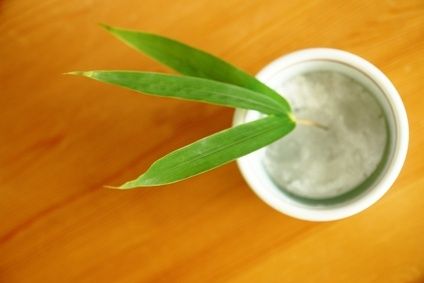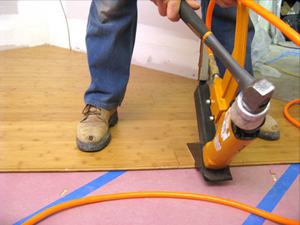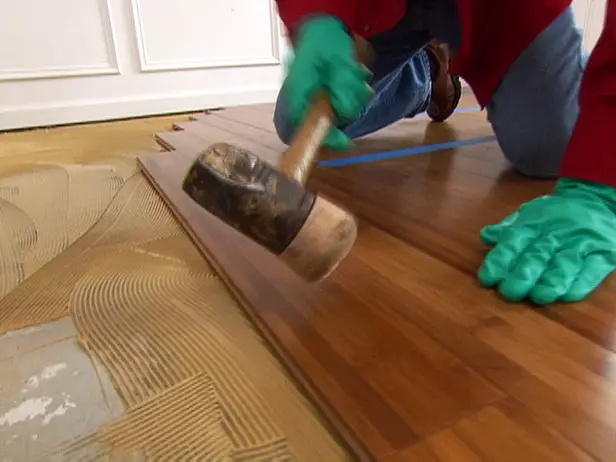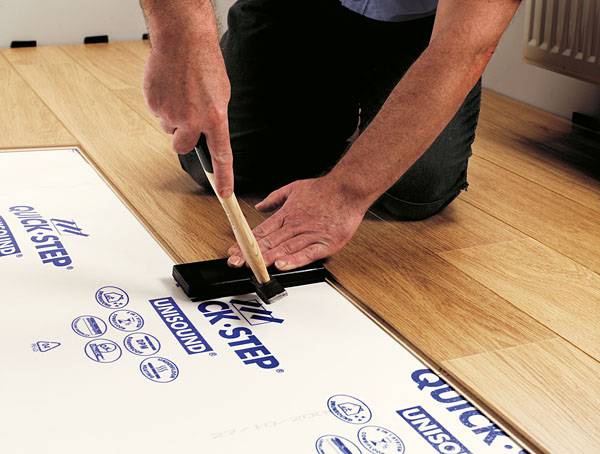After we’ve carefully prepared the subfloor for our DIY flooring installation, we are now ready to put in our bamboo flooring. First, make sure you get your measurements and lines straight, you can have a dry layout of the planks in a few rows before securing the same with nails or adhesive.
 Some things to consider in installing bamboo flooring planks are the longest wall in the room, the direction of the light to conceal seams impact as well as windows and entryways.
Some things to consider in installing bamboo flooring planks are the longest wall in the room, the direction of the light to conceal seams impact as well as windows and entryways.
Experienced DIYers can cover about 200 square feet in a day.
1. Nailed-down Installation – also referred to as secret nailing method, this is the traditional way of installing bamboo flooring, as well as other wooden flooring materials using nails or staples. Here, nails will be rammed on the tongue side of the plank to be nailed on flooring joists using a blind nailer, hence the name secret nailing since the next row will conceal the nails on the tongue of the previous ones.
 The challenge here would be the identification and marking or the flooring joists. Each piece of flooring should be nailed every 8 inches and within 2 inches of each end at a 45º angle.
The challenge here would be the identification and marking or the flooring joists. Each piece of flooring should be nailed every 8 inches and within 2 inches of each end at a 45º angle.
As it is with normal hardwood flooring installation, the first and last rows would have to be face-nailed.
Lastly, checkout manufacturer’s instructions to see if there are recommended putties to help you conceal nail holes on the floors.
2. Glued-down Installation – this process mimics that of installing tile flooring. This application is suitable for both wooden and concrete subfloors. Some adhesives are formulated to resist moisture build up eliminating the need to use vapor or moisture barriers.
 Some adhesive are available ready for use while some would have to be mixed. Be sure to follow manufacturer’s instructions and recommendations when mixing the adhesive from the amount of water required to the ideal consistency of the mixture and the appropriate trowel size.
Some adhesive are available ready for use while some would have to be mixed. Be sure to follow manufacturer’s instructions and recommendations when mixing the adhesive from the amount of water required to the ideal consistency of the mixture and the appropriate trowel size.
 Begin on the side of the wall with the first plank’s grove facing the wall. Make sure that there is enough ventilation in the room and don’t forget the recommended expansion gap. If curing is allowed prior to laying out the planks on top of the adhesive, be sure to do just that.
Begin on the side of the wall with the first plank’s grove facing the wall. Make sure that there is enough ventilation in the room and don’t forget the recommended expansion gap. If curing is allowed prior to laying out the planks on top of the adhesive, be sure to do just that.
Ensure that planks are straight and correctly aligned. Immediately wipe off excess adhesive on top of the flooring using a damp cloth and walk on the flooring – every square feet of it to make sure that the planks would bond with the adhesive. Use weights as needed.
3. Floating Floor – this refers to gluing only the tongue and groove of the bamboo flooring planks installed over underlayments and other recommended cushions. This is generally recommended for radiant heat and ideal for below grade installations.
 Begin on one side of the wall, groove facing the wall. Apply adhesive on the tongue and grooves successively. Lay subsequent rows of planks and use a tapping block to securely lock them. For the ends of each row, use a pry bar for a needed push.
Begin on one side of the wall, groove facing the wall. Apply adhesive on the tongue and grooves successively. Lay subsequent rows of planks and use a tapping block to securely lock them. For the ends of each row, use a pry bar for a needed push.

